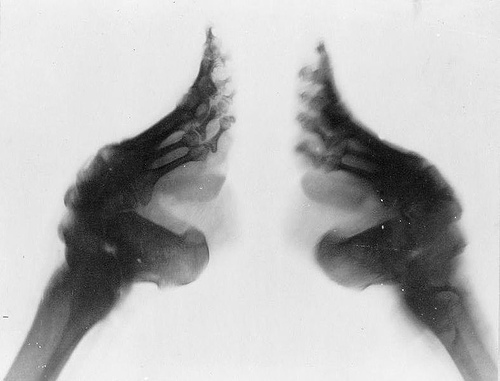Throughout his entire professional career, Andy Kaufman kept a day job busing tables at Jerry’s Famous Deli in Los Angeles.
Oddities
Jastrow Illusion

An optical illusion. The two figures are the same size.
No, Seriously

There’s never a good time for a tsunami, but the one that hit Hawaii in 1946 (visible at center right) was particularly unfortunate. It landed on April 1, and many residents dismissed the warnings as an April Fools prank. Ultimately 165 people died.
Library Hotel
New York’s Library Hotel has 10 floors, each decorated according to a major category in the Dewey Decimal System. Each room has its own subcategory or genre, including appropriate books and art. Rooms:
- Third Floor: Social Sciences. 300.006 Law, 300.005 Money, 300.004 World Culture, 300.003 Economics, 300.002 Political Science, 300.001 Communication
- Fourth Floor: Language. 400.006 Ancient Language, 400.005 Middle Eastern Language, 400.004 Asian Language, 400.003 Germanic Language, 400.002 Romance Language, 400.001 Slavic Language
- Fifth Floor: Math and Science. 500.006 Astronomy, 500.005 Dinosaurs, 500.004 Botany, 500.003 Zoology, 500.002 Geology, 500.001 Mathematics
- Sixth Floor: Technology. 600.006 Health & Beauty, 600.005 Computers, 600.004 Medicine, 600.003 Management, 600.002 Manufacturing, 600.001 Advertising
- Seventh Floor: The Arts. 700.006 Fashion Design, 700.005 Music, 700.004 Photography, 700.003 Performing Arts, 700.002 Paintings, 700.001 Architecture
- Eighth Floor: Literature. 800.006 Mystery, 800.005 Fairy Tales, 800.004 Dramatic Literature, 800.003 Poetry, 800.002 Classic Fiction, 800.001 Erotic Literature
- Ninth Floor: History. 900.006 Biography, 900.005 Geography & Travel, 900.004 Asian History, 900.003 Oceanography, 900.002 Ancient History, 900.001 20th Century History
- Tenth Floor: General Knowledge. 1000.006 New Media, 1000.005 Journalism, 1000.004 Museums, 1000.003 Encyclopedic Works, 1000.002 Almanacs, 1000.001 Libraries
- Eleventh Floor: Philosophy. 1100.006 Love, 1100.005 Paranormal, 1100.004 Psychology, 1100.003 Philosophy, 1100.002 Ethics, 1100.001 Logic
- Twelfth Floor: Religion. 1200.006 Ancient Religion (Mythology), 1200.005 Native American Religion, 1200.004 Germanic Religion, 1200.003 New Age, 1200.002 African Religion, 1200.001 Eastern Religion
Worse Than High Heels

The Chinese practice of footbinding, popular since medieval times, was banned only in 1911. Young girls’ feet were wrapped in bandages to prevent them from growing longer than 4 inches. By age 3, four toes on each foot would break, often leading to infection, paralysis and atrophy. Some elderly Chinese women today still show disabilities.
Watts Towers

“Let each man exercise the art he knows,” wrote Aristophanes 2400 years ago. That spirit inspired Italian immigrant construction worker Sabato Rodia, who spent 33 years building the Watts Towers in his spare time.
“I had in mind to do something big and I did it,” he said. He started work in 1921, and by 1954 he’d created 17 interconnected structures, some nearly 100 feet tall. His materials included broken pottery, scrap metal, bottles, bed frames, and seashells, and he assembled them using hand tools and window washers’ equipment.
Rodia finally gave up and left after repeated vandalism — local rumors said the towers were antennae for communicating with the Japanese. But when the city actually broke a crane trying to knock them down, it changed its mind and preserved the site as a state historical park.
Orbison Illusion

An optical illusion. The diamond and the bounding rectangle are square, not distorted, as they appear.
Galactic Dibs

On New Year’s Day, 1949, James Mangan went to the Cook County recorder of deeds and registered his own country. The Nation of Celestia, he said, encompassed all of outer space. He was claiming it, as “founder and first representative,” to prevent anyone else from establishing political hegemony there.
Mangan wasn’t shy about it, either. Later that year he informed the United States, the Soviet Union, the United Kingdom, and the United Nations that he was banning atmospheric nuclear tests, and he sent angry letters to the Americans and the Soviets when their space flights infringed on his “territory.” He even briefly got the U.N. to add the Celestian flag to those of its member nations.
Still, the idea never caught on, it largely died with its founder. All that’s left are some stamps, coins (“celestons”), and the titles Mangan gave to his grandsons: Glen Stump, “Duke of Selenia,” Dean Stump, “Duke of Mars,” and Todd Stump, “Duke of the Milky Way.”
Space to Let
Times are hard everywhere, but shed a tear for the Kongo Gumi Company of Osaka, Japan. When it closed its doors in January, the construction firm had been operating continuously for 1,400 years. The family business built its first temple in the year 578 and could trace its leadership through 39 generations.
Sssssss

What do you get when thousands of drunken sports fans stack their beer cups into a huge chain? A beer snake, that’s what. They’re not very dangerous, as snakes go — they tend to appear at cricket matches, which take hours and sell a lot of beverages. But they get big: The largest so far measured 23 meters. Cheers.
